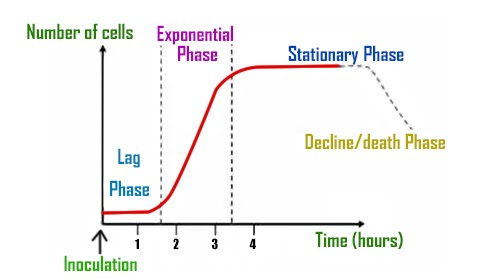
Typical growth curve in plants is
(a) Sigmoid
(b) Linear
(c) Stair steps shaped
(d) Parabolic
Answer
417.9k+ views
1 likes
Hint: Most of the living organisms follow a similar kind of growth pattern. The preparatory stage, exponential stage, and stationary stage. The graph formed will be ‘S’ shaped. It is used to observe the growth of culture bacteria.
Complete answer:
The graph of the growth curve in plants will be sigmoidal in shape. The growth curve is characterized by 4 different phases as mentioned below.
1. Lag phase: The biological systems experience an initial phase that exhibits a slow-growing process. This is called the 'lag phase.' During the lag phase, the cells will prepare themselves for cell division.
2. Log phase: The log phase is characterized by the actual cell division and it increases the number of cells. It is also called an exponential phase. Here the daughter cells begin to divide after the mitotic cell division. The number of live cells will be maximum in the log phase. Thus it can be observed that there will be a steep rise in the graph from the lag phase to the log phase.
3. Exponential phase: The cell growth gradually slows down due to the limited supply of nutrients (nutrients will be used up for the cell growth and hence the cells will become devoid of nutrients), giving rise to the 'stationary period.' During the stationary phase, the number of new cells formed will be equal to the number of cells that die.
4. Death phase: During the death phase, the cells will become senescent (old) and will eventually die. When we plot a graph for growth (number of bacteria) vs time, we get a sigmoidal curve or S-curve. This growth curve is characteristic of all cells, tissues, organs, and is representative of an organism that lives in a natural environment.
The below image represents the growth curve.

So, the correct answer is ‘Sigmoid’.
Note:
Plants react to the environment and phases of life in different ways and give rise to various types of structures. This is called plasticity. Example-The leaves of a young cotton plant vary from a mature cotton plant in shape. In addition, buttercup plant leaves growing in the air have a different shape than those growing in water. This process of generating different forms is called heterophylly.
Complete answer:
The graph of the growth curve in plants will be sigmoidal in shape. The growth curve is characterized by 4 different phases as mentioned below.
1. Lag phase: The biological systems experience an initial phase that exhibits a slow-growing process. This is called the 'lag phase.' During the lag phase, the cells will prepare themselves for cell division.
2. Log phase: The log phase is characterized by the actual cell division and it increases the number of cells. It is also called an exponential phase. Here the daughter cells begin to divide after the mitotic cell division. The number of live cells will be maximum in the log phase. Thus it can be observed that there will be a steep rise in the graph from the lag phase to the log phase.
3. Exponential phase: The cell growth gradually slows down due to the limited supply of nutrients (nutrients will be used up for the cell growth and hence the cells will become devoid of nutrients), giving rise to the 'stationary period.' During the stationary phase, the number of new cells formed will be equal to the number of cells that die.
4. Death phase: During the death phase, the cells will become senescent (old) and will eventually die. When we plot a graph for growth (number of bacteria) vs time, we get a sigmoidal curve or S-curve. This growth curve is characteristic of all cells, tissues, organs, and is representative of an organism that lives in a natural environment.
The below image represents the growth curve.

So, the correct answer is ‘Sigmoid’.
Note:
Plants react to the environment and phases of life in different ways and give rise to various types of structures. This is called plasticity. Example-The leaves of a young cotton plant vary from a mature cotton plant in shape. In addition, buttercup plant leaves growing in the air have a different shape than those growing in water. This process of generating different forms is called heterophylly.
Latest Vedantu courses for you
Grade 11 Science PCM | CBSE | SCHOOL | English
CBSE (2025-26)
School Full course for CBSE students
₹41,848 per year
EMI starts from ₹3,487.34 per month
Recently Updated Pages
Master Class 9 General Knowledge: Engaging Questions & Answers for Success

Master Class 9 English: Engaging Questions & Answers for Success

Master Class 9 Science: Engaging Questions & Answers for Success

Master Class 9 Social Science: Engaging Questions & Answers for Success

Master Class 9 Maths: Engaging Questions & Answers for Success

Class 9 Question and Answer - Your Ultimate Solutions Guide

Trending doubts
State and prove Bernoullis theorem class 11 physics CBSE

What are Quantum numbers Explain the quantum number class 11 chemistry CBSE

Who built the Grand Trunk Road AChandragupta Maurya class 11 social science CBSE

1 ton equals to A 100 kg B 1000 kg C 10 kg D 10000 class 11 physics CBSE

State the laws of reflection of light

One Metric ton is equal to kg A 10000 B 1000 C 100 class 11 physics CBSE




